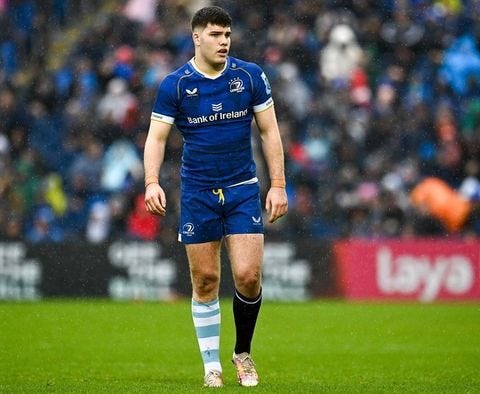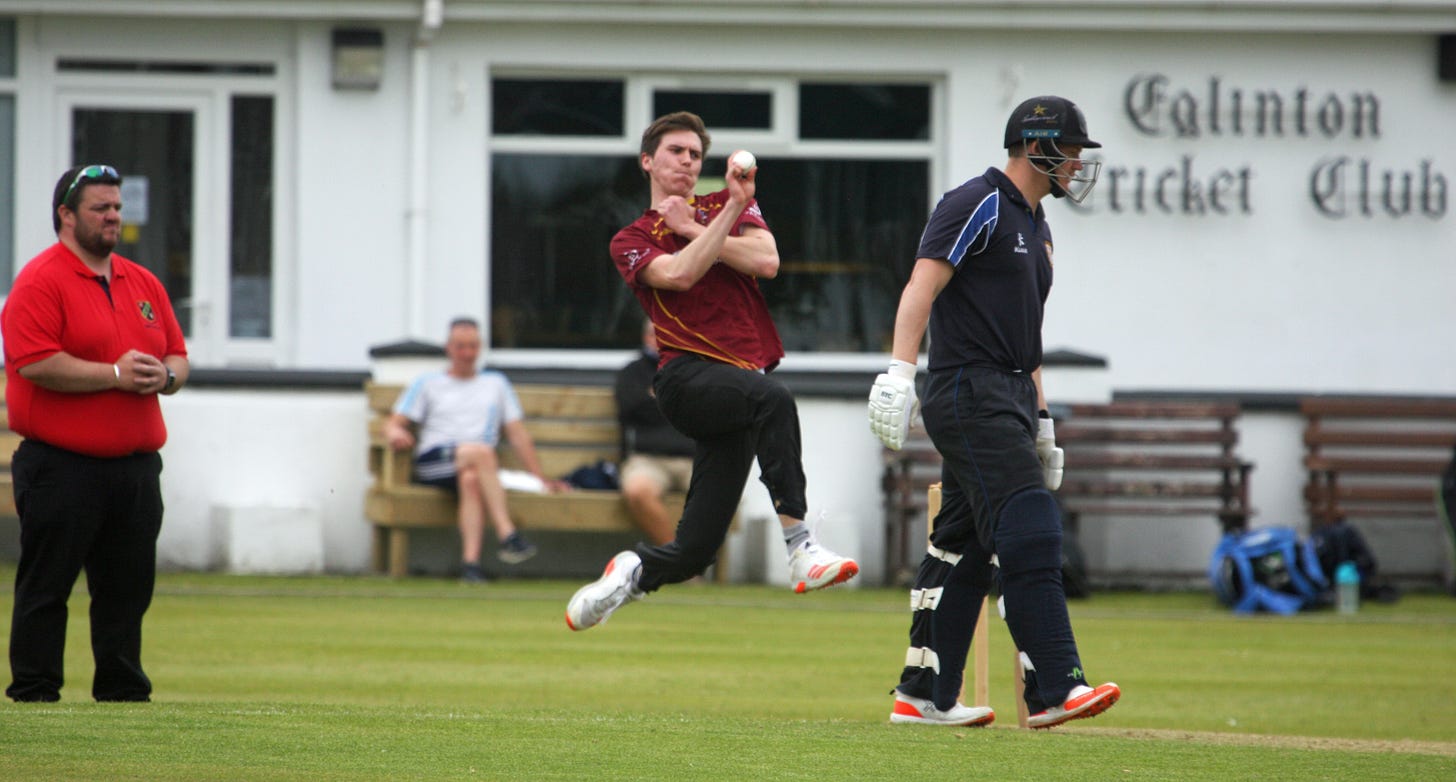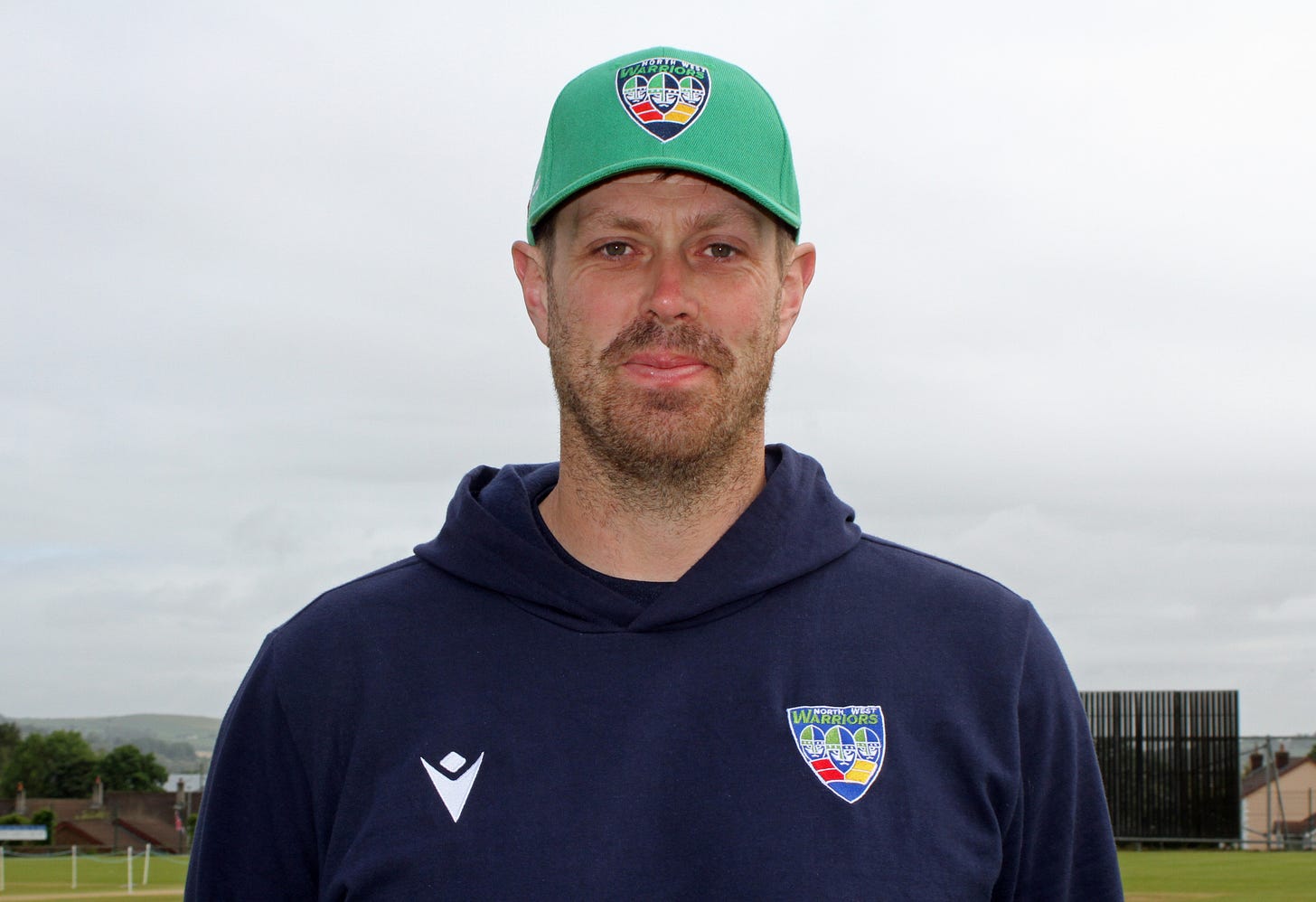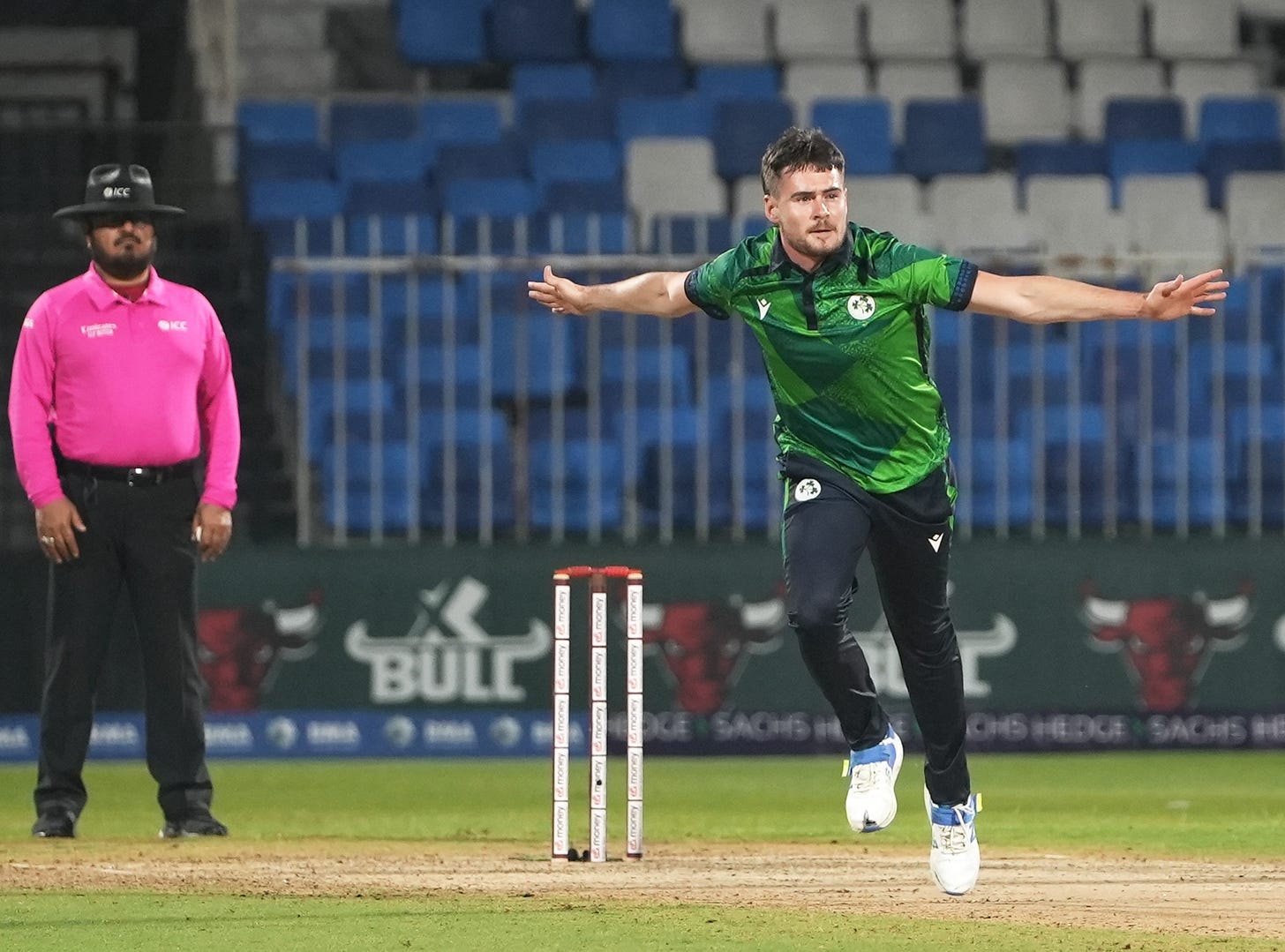Where are Ireland's fast bowlers?
As world cricket continues to look for more pace, how can the Irish system produce more speedsters?
Back during the 2022 T20 World Cup, a familiar face walked in front of the MCG press box. After stopping for a friendly word with Irish journalists, he returned to his friends to watch Ireland take on England from the stands.
“Who was that?” asked an English writer.
“David Delany.”
“Wow, what’s he doing here?”
This particular colleague has, as far as English hacks go, a good knowledge of Irish cricket. He had seen the Twitter chatter clamouring for the selection of a bowler who, when playing Ireland in 2019, had once been clocked at 147 kilometres per hour - 92 miles in old money.
Delany was in Melbourne playing club cricket for the winter. He was not in the World Cup squad.
A different English journalist overheard our conversation. He had no idea who Delany was. When informed of his potential pace, alongside the mysterious off-field reasons for his non-selection, he responded bluntly.
“Who cares? Ireland need fast bowling. Get him in.”
This isn’t a piece on the merits or otherwise of Delany’s five-year absence from international cricket. That is a story for another day. Instead, it is a reflection of a truth evident even to outside observers who rarely pay attention to Irish cricket.
On this island, we don’t develop enough fast bowlers.
Speaking before his first summer in charge back in 2022, men’s head coach Heinrich Malan acknowledged the issue. “From a seamers point of view, we’ve got three or four guys that have shown they can really do a good job but how do we add more?” he said.
"How do we develop that guy who can bowl 135 kmh (85 miles) plus for 20 overs a day?”
As the global game produces flatter pitches offering less lateral movement, pace is becoming king. Countries like England have realised this, accumulating a battery of quicks including Joffra Archer, Mark Wood, Gus Atkinson and Brydon Carse.
If it hasn’t happened already, Ireland risks being left behind. Reliant as they are on a group of seamers whose skills can often be enough to win matches, a hole will appear once the current experienced crop starts to drop off. “In two years, we’ll be ringing up Aussies with passports,” warns one international bowler.
Why does Ireland find it so hard to produce raw speed, and what can be done about it?
Pace isn’t everything, but it is important. A recent article in the Telegraph outlined the statistical argument. Between 2015 and the start of last summer, balls bowled at 79-81 mph in Test matches took a wicket every 63.7 balls. At 83-85 mph, that strike-rate dropped to 52.4. When touching 90mph, a wicket falls every 47.6 deliveries. The quicker you bowl, the more regularly wickets fall.
Since their return to Test cricket in 2023, Ireland have bowled just one per cent of deliveries above 85mph.
In white ball cricket, once the new ball stops moving, sides have increasingly turned to fast bowling to buy wickets in the middle overs. Ireland have for a long time struggled in that period of the game.
Josh Little is the only recent Irish bowler to consistently show true pace, being clocked at a high of 147kph/92mph. Alongside Delany, who fell out of international contention and did not hit high speeds when bowling with an injured foot in domestic action this year, Conor Olphert had been identified as a potential fast bowler. He made his debut in 2022 against India. Due to injuries, he hasn’t played since and he no longer has an Ireland contract.
Craig Young, Olphert’s clubmate up in Bready, touched the 90mph mark earlier in his career. Like Olphert, he has been blighted by injury and now bowls closer to 80mph.
While Ireland doesn’t have the best record at ensuring fast bowlers stay fast for an extended period, the issues start before these players reach the international game. Not enough options are coming through the pipeline. After speaking to current and former players, coaches and other fast bowling experts, a number of factors explain this dearth.
The easiest place to start is competition. There are 13,000 club cricketers in Ireland. 50,000 people are registered members of rugby clubs, 105,000 in football clubs and 325,000 in GAA clubs. More so than batters, fast bowlers must have a certain athletic profile. Odds are, anyone who has it is involved in a different sport.
Even if they are playing cricket, competing activities can impact their bowling development. One pathway coach told a young quick not to bowl until the new year, such are the physical requirements of his winter rugby exploits. The risk of injury when combining a contact sport with bowling is simply too high.
If a dual-sport player does manage to stick at both long enough to contemplate a professional career, the other sport is likely to be more lucrative. Little has become a millionaire on the franchise circuit but he is an outlier. Compared to other sports, Irish seam bowlers are not rich men.
In 2010, Jordan Coghlan opened the bowling for Ireland U19s against an Australia side captained by Mitch Marsh. His talent caught the eye of the Aussie coach, Greg Chappell. Instead of progressing in cricket, Coghlan went on to play rugby for Leinster, Munster, Leicester and Nottingham.
Ben Brownlee is a more recent example. The winner of Cricket Leinster’s Find a Fast Bowler competition in 2015, he too chose the oval ball sport. Brownlee has since won an U20 Six Nations Grand Slam with Ireland before playing as a centre for Leinster.
For those who do stick to cricket, the actual process of learning how to bowl at high pace is not easy.
“Conditions aren’t conducive to bowling fast in Ireland,” explains Peter Johnston, the head of Ireland’s academy. “You get better outcomes if you’re accurate and hit the top of the stumps. Even when you go to England, the pitches have far more pace and bounce, along with movement. Here, they’re more tired more often.”
Allan Eastwood, a tall fast bowler who played for Ireland 14 years ago, agrees. “The pitches then were worse,” he says. “They’re much, much better now, but I remember playing in Belvedere on an absolute quagmire of a pitch, the ball isn’t going above ankle height. Then it’s a detriment to bowl fast, because the faster ball coming onto the bat is easier to play.
“Another issue is ground size. Playing in Rush, a small nick on the off-side is six if you’re bowling a short ball. Maybe third man gets round to catch that on a big ground. We played for the Irish over-40s in Newport and their second ground was bigger than most grounds in Leinster.
“People get caught up in wickets and economy rates.”
Eastwood hints at a wider attitude problem. England have started selecting fast bowlers based on physical attributes rather than their results in county cricket. Recognising that the pace required to be successful on the international stage can sometimes be a detriment at club level is an ongoing process in Ireland.
“I was always told to hit the top of off as a youngster,” says current Ireland international Barry McCarthy. “I was never told to just let it rip.”
“I went about things from a young age, ‘I’m not listening to my coach, I’m just going to bowl as fast as I can,’” says Olphert, one of the quickest bowlers in the Irish system until his injury troubles. “I wasn’t the most accurate, but people knew I could bowl fast.
“'Your technique is off, you’re falling over,’ whatever. I just refused to listen to it. It took me so far, it took me to playing fairly well at Bready and my initial stages of getting into the North West Warriors. That’s when I started to look at my action and try improve things. After all the work I had done, you have to stick to your guns. You have to want to bowl fast. You have to be a wee bit selfish and be self-learning.”
Boyd Rankin, the former Ireland and England fast bowler, is from the same club as Olphert and Young - Bready in the North West. “Myself and Youngy grew up on family farms, so we were always slightly stronger than most other guys my age” explains Rankin. “I don’t know if it’s a coincidence or not.
“Looking at the three of us, we all had a mentality to bowl as quickly as possible back in our younger years. Potentially now, we go a different way about it. Especially bowling in Ireland, if you can bowl a good line and length, generally you’re going to pick up wickets. I don’t think that helps us in terms of fast bowling. The likes of myself and Youngy spent a lot of time over in England on harder pitches. That helped.”
As coach of the North West Warriors, one of Ireland’s four List A teams, Rankin is trying to bring this attitude shift down through the younger generations. “We’re doing a lot of trials for the pathway stuff,” he explains. “This is going out to club coaches who select players to come forward to trials. One of the things we say is, ‘We want to see somebody that bowls fast’. Some coaches might go, ‘He bowls quick but he’s all over the place’ so they won’t put him forward for a trial, but that’s the person I want to see. You can teach them how to land it and get more consistent.”
Pace first, accuracy second. “Exactly,” says Rankin. “Not everyone can bowl quick, but it’s really difficult if they have the skill but they’re bowling 78, 79 mph. They’re not going to automatically jump up 10 mile an hour.”
Part of the attitude problem is actually telling how quick someone is. Reliable speed guns are a scarce resource in Ireland. One pathway coach said he has a radar but needs a more expensive one which he actually trusts. A young bowler currently in the Irish system bought his own speed gun.
One current international wasn’t clocked until the age of 23 when an English county coach travelled over to do some specialist work at the invitation of Cricket Ireland. Nathan Hauritz had a speed gun when he was Ireland’s spin coach, but he left last year.
Another part of the explanation for grassroots attitudes is a simple lack of knowledge. Ross Dewar, Steffan Jones and Paul Felton are all UK-based experts who offer biomechanics advice - ‘braced front leg’ and the like. A number of Irish bowlers and coaches have interacted with them, either in person or online, illustrating a desire to learn.
Below the top level of coaching, there is a lack of knowledge of the body movements required to bowl fast. By the time fast bowlers get to play for Ireland in their 20s, often it is too late to physically develop them into top end speedsters. “If I had the biomechanic awareness I do now - I don’t want to say I’d be rapid - but I would love to see where I am,” says Barry McCarthy.
“I personally would say we need more knowledge,” says Rankin. “It’s difficult, Ryan Eagleson is Ireland’s lead bowling coach and he spends a lot of time away on tour. We don’t have anyone in beneath that.
“I would do a lot of stuff in the North West and I’ll help other bowlers in the NCU and Dublin. Ideally it’s the same as what the England Cricket Board would have, you have your lead fast bowling coach who’s looking after all the senior stuff but you need someone below that who can oversee another batch of young fast bowlers coming through.”
Unsurprisingly, as with most problems in Irish cricket, a lack of domestic first-class red ball games is a root cause. “You need pace in multi-day cricket and we don’t play enough of it on good surfaces,” says academy boss Johnston. “Liam McCarthy got a good run against the Emerging West Indies during that series this summer. He showed how effective he could be bowling aggressively, bowling a bouncer plan.”
“For me personally, a lot of learning in terms of bowling comes from red ball cricket and being able to bowl spells and back it up with another spell,” says Rankin. “You learn a lot about your body and how to bowl with skill and still keep your pace up.
“We can keep trying to help the younger guys coming through, but at the same time, they still need to bowl. I don’t think we bowl enough in Ireland. Weather is a massive factor in that.”
Pace in women’s cricket is a different issue (worth longer explanation in its own right, in time). Plenty of the same issues in terms of conditions, athletic competition and coaching attitudes remain. Like the men’s senior team, there is a national seam bowling coach, Glenn Querl, but he too lacks specialist support underneath him. Do enough people in the country know what a women’s body needs to do to bowl fast?
The saving grace would be that Ireland is just one of countless countries which doesn’t have a stellar record of producing female fast bowlers. The gap, therefore, isn’t as damaging. That said, should things improve, this does present an opportunity to get ahead of the global curve. As alluded to, it is too important a topic which warrants its own exploration.
Given all of the above, it’s hard enough to produce fast bowling prospects. Ireland can’t then afford to not capitalise when the pathway does throw up a rare diamond. A handful of young bowlers have headed to South Africa and Australia for the winter, some with help from Cricket Ireland, others through finding their own opportunities. Closer to home, a CI spokesman says that a men’s fast bowling programme is “starting shortly.”
When this programme does emerge, especially with Eagleson - Ireland’s senior fast bowling coach - away on tour for much of the year, shared plans at all levels will be required. Some coaches below the national team suggest this is lacking, with multiple saying they had not even been made aware of this upcoming programme. Some coaches feel a focus on short term senior results can lead to a lack of collaboration. “I don’t think those conversations have happened enough,” says one figure. “I don’t think there’s any inquisitiveness about the pathway from certain coaches.”
Similar thinking extends to the interpros. If a fast bowling prospect goes for runs on a small ground in a must-win game, will the captain and coach keep bowling him, putting the required overs into his legs to develop? Multiple figures involved suggest a big picture focus is prevalent at the emerging interpro level where results are not paramount. Less so among senior teams when coaches are under pressure from the provincial unions to deliver silverware.
What can be done? Educating grassroots coaches on the necessary attitudes and techniques to bowl fast is one thing. A more streamlined solution would be to increase the contact time between prospects and senior coaches who have the expertise.
“There is a big push to help those young fast bowlers, to try to work out who the next young batch are, help them with biomechanics, try and cover all the basics, S&C, physio, psychology, try to give them as much support as possible,” says Rankin. “It’s still a massive work in progress.”
While Rankin was at Warwickshire, his then 19-year-old teammate, Chris Woakes, was among a group of young, county contracted fast bowlers taken by England to Florida to undergo strength and fitness training. Ireland will never be able to afford that, but any sort of specialist work is difficult given this fast bowling programme should be aimed at players without an Ireland contract.
“We’re more disadvantaged in the North West than a lot of the other unions because the mentality would be, finish school - they might go to uni - then go straight into a job,” explains Rankin. “Whereas maybe elsewhere you might get support from your parents for a year or two to try and make it.
“I totally understand now where a young bowler coming through, if he’s got work all day and is expected to do gym, bowl, it is difficult. In an ideal world you would have all these lads on some sort of contract so they have the opportunity to get stronger, fitter and help with their skill stuff, and to rest, which is so important.”
Johnston agrees, arguing that, given the physical demands of fast bowling, Ireland’s system for those players should be tweaked. “Fast-tracking them to senior pro contracts is a potential idea,” he explains. “You’re probably only talking one or two, but rather than sitting back and saying ‘Let’s see if this guy proves himself,’ if you see those indicators of real pace, you see the athlete in terms of fast bowling, you need to back them earlier.”
“Bowling fast takes a team and state of the art equipment,” says one Ireland bowler. “Speed guns, biomechanical analysis suits, slow motion cameras, etc.” While Cricket Ireland did receive a significant funding hike from the ICC this year, the organisation remains in debt. There already is a lengthy list of desired investments.
Ireland have a T20 World Cup in India in 2026, followed by a bid to qualify for the ODI World Cup in South Africa in 2027. “Two countries with flat pitches where extra pace is so important,” points out one international. Given the fast bowling programme has not yet started, unexpected success stories such as Little will be have to be relied upon in the short term. When asked what made him a consistently fast bowler, one figure close to Little replied, half-jokingly, “Luck.”
When Ireland were swatted aside by England at Lord’s last year, captain Andrew Balbirnie explained how, at one stage, he was looking around the changing room wondering how he could manufacture wickets. Such was England’s dominance against a medium pace attack on a batter-friendly surface.
Ireland won’t always have such desperate days. Certain venues may throw up conditions which bring swing and seam more into play. Yet when it comes to World Cups in countries that are expected to produce flat pitches, Ireland remains at a disadvantage.
Money problems, conditions and an inability to train outdoors during the winter can’t always be helped. Coaching knowledge and clear plans from international level right down through the pathways should be fixable. Above all, Irish cricket needs a widespread cultural change; to embrace everything pace can bring. It may lead to difficult days for clubs and even interpro sides, but the long term goal must be to develop players for Ireland, regardless of the short term pain.
Some people are trying to drive this change. Their success, or lack thereof, in developing fast bowlers will play a major role in shaping the national team’s fortunes.












